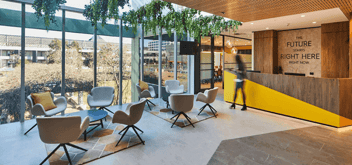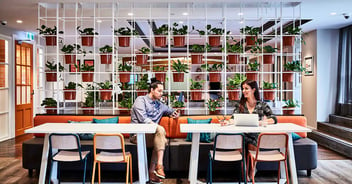While many employees have worked from home since March, companies are now planning or are amid their return-to-office strategies. Although we may be returning to the office, the pandemic has changed the way we work forever. The current affairs have also provided an opportunity to redesign and reimagine your office space with an Activity-Based Working strategy while still prioritising employee health and safety.
The journey towards activity-based working
Activity-Based Working (ABW) has been around since the 1980s but grew in popularity during the 1990s as more companies implemented activity-based working throughout their offices. And although at first glance it may appear that the pandemic may have halted the trajectory of ABW, it really couldn’t be further from the truth.
ABW is a style of workplace design that enables employees to choose the best environment to suit their individual working style. So rather than sitting day-in, day-out at an office desk, the employee can change it up depending on what task they’re doing – whether that’s collaborating with others in a brainstorming space or working from home for deep work.
ABW is commonly confused with hot-desking, which removes allocated seating to inspire mobility and maximise office space. But it’s more than that. ABW is about supporting employees while they’re in (and out of) the office, so they perform at their best every day.
How the pandemic has changed the requirements of the office
COVID-19 has been a catalyst for many organisations to rethink how ‘work’ gets done. And it has started many on a path to trusting and empowering their employees to work where and even when they work best.
Given one of the critical tenets of Activity-Based Working is the empowerment of the employee, it’s clear ABW is an excellent match for the future workspace. Naturally, challenges to working in a shared space in the pandemic-era have arisen. Let’s explore their solutions.
Physical distancing
Keeping 1.5 metres apart in a shared workspace is a challenge all companies face as they have employees return to the office. An ABW design has the flexibility to accommodate distancing requirements physically in the office as well as by empowering employees to work remotely when needed. Consider capacity based on physical distancing guidelines and plan ahead for those coming into the office – A/B shifts or flexible working hours can help.
High contact areas
In any office, whether ABW or not, there are high contact areas like light switches and elevator buttons which need to be considered. In the first instance, a frequent and thorough cleaning schedule for these areas will need to be implemented. In the longer term, consider touchless technology or automation to avoid contact altogether. Shared spaces like kitchens, bathrooms and thoroughfares also need to be considered. Wayfinding and physical distancing signage can be helpful to keep employees moving in the right direction and maintaining a proper distance from one another.
Provide employees with their own equipment like keyboards or headsets, so they are not shared between coworkers. Also, ensure cleaning and disinfecting supplies are readily available for employees to use as required between scheduled cleaning. Additionally, make sure there is enough time between workspace handover to allow for cleaning and disinfecting to take place.
Technology solutions
Besides the physical workplace, employees also need an efficient digital working environment, affording instant access to all important information, anywhere and at any time. As well as the technology tools to efficiently collaborate with colleagues, wherever they may be. Technology solutions we are keeping a close eye on are:
- Space utilisation software: Used to optimise how people interact with their flexible work environment.
- Environmental health and comfort: Sensors used to monitor things like temperature, humidity and air quality for a comfortable and safe working environment.
- Personal wayfinding: Occupancy sensors used to gather data and create interactive floor plans on kiosks or mobile apps.
Thanks to its nature of flexibility, with the right planning, ABW means your employees will return to a responsive, adaptive, modern office which they are confident will keep them safe and well.
Wondering how else COVID-19 has changed the future of work? This is one of the topics we explore in A progressive leader’s guide to the Future of Work in Australia.






